Antialiasing#
We construct an A/B corner mix image where, in each 2x2 tile, the top-left pixel comes from image A and the other three come from B. Then we downsample by 0.5 using:
Standard interpolation (cubic): a non-anti-aliased decimation.
Least-squares projection (cubic-best anti-aliasing): an anti-aliased decimation.
Imports#
import numpy as np
import requests
from io import BytesIO
from PIL import Image
from splineops.resize.resize import resize
from splineops.utils import show_roi_zoom
Load and prepare base ROI#
Load A and B, convert to grayscale, and define the ROI on the originals.
URL_A = "https://r0k.us/graphics/kodak/kodak/kodim14.png"
URL_B = "https://r0k.us/graphics/kodak/kodak/kodim08.png"
ROI_SIZE_PX = 64 # original ROI side (pixels)
FACE_ROW, FACE_COL = 250, 445 # ROI center (approx) in ORIGINAL coordinates
zoom = (0.5, 0.5) # 0.5× downsampling demo
def to_gray01(img_rgb_uint8: np.ndarray) -> np.ndarray:
g = img_rgb_uint8.astype(np.float64) / 255.0
return 0.2989 * g[..., 0] + 0.5870 * g[..., 1] + 0.1140 * g[..., 2]
A = to_gray01(np.array(Image.open(BytesIO(requests.get(URL_A, timeout=10).content))))
B = to_gray01(np.array(Image.open(BytesIO(requests.get(URL_B, timeout=10).content))))
assert A.shape == B.shape, "Images A and B must have identical shape."
h_img, w_img = A.shape # ORIGINAL canvas size (e.g., 512×768)
# Original ROI (face) — top-left corner (for show_roi_zoom)
row_top = int(np.clip(FACE_ROW - ROI_SIZE_PX // 2, 0, h_img - ROI_SIZE_PX))
col_left = int(np.clip(FACE_COL - ROI_SIZE_PX // 2, 0, w_img - ROI_SIZE_PX))
# Keep the ROI center as *relative* position for later (downsampled views)
rel_center_r = FACE_ROW / h_img
rel_center_c = FACE_COL / w_img
roi_kwargs_orig = dict(
roi_height_frac=ROI_SIZE_PX / h_img,
grayscale=True,
roi_xy=(row_top, col_left),
)
Image A (with ROI)#
_ = show_roi_zoom(A, ax_titles=("Image A (with ROI)", None), **roi_kwargs_orig)
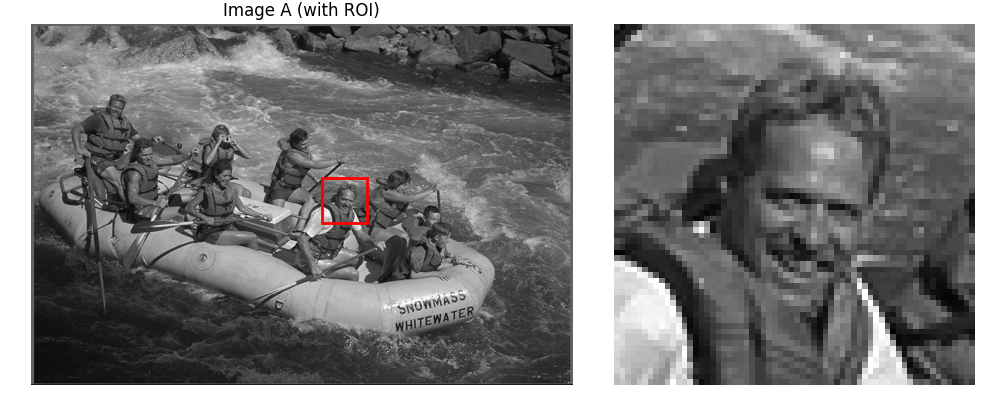
Image B (with ROI)#
_ = show_roi_zoom(B, ax_titles=("Image B (with ROI)", None), **roi_kwargs_orig)
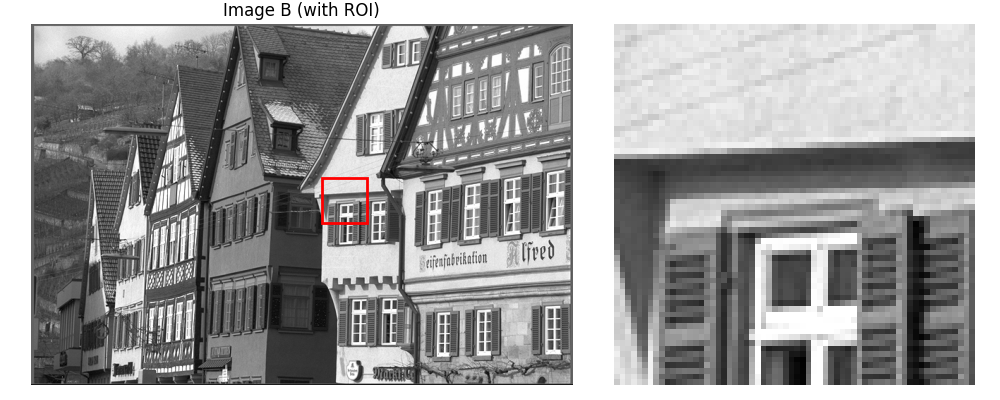
Construct A/B corner mix#
A fills the top-left of each 2×2 block; the other three pixels come from B.
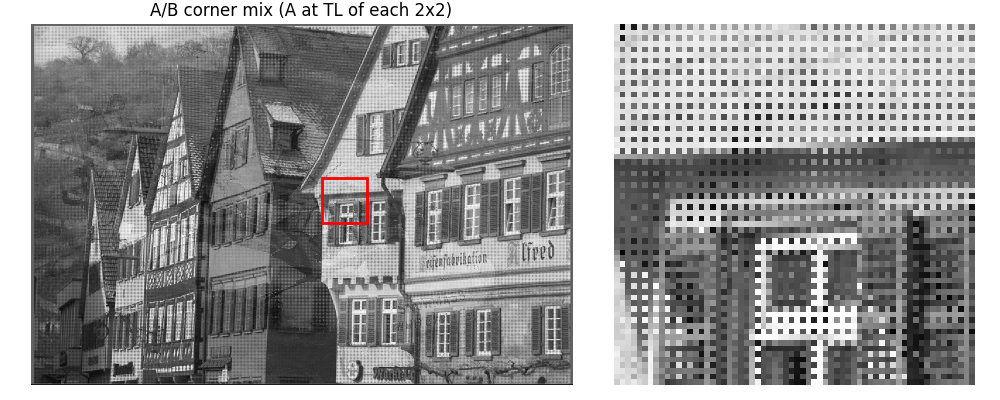
Resized (standard)#
H, W = mixed.shape
if (H % 2 == 0) or (W % 2 == 0):
mixed_odd = mixed[:H - (H % 2 == 0), :W - (W % 2 == 0)]
else:
mixed_odd = mixed
h_odd, w_odd = mixed_odd.shape
assert (h_odd % 2 == 1) and (w_odd % 2 == 1), "Expect odd H×W after the crop."
res_std = resize(mixed_odd, zoom_factors=zoom, method="cubic") # standard (cubic)
res_ls = resize(mixed_odd, zoom_factors=zoom, method="cubic-best_antialiasing") # least-squares (best AA)
def show_resized_on_original_canvas_same_relpos(resized: np.ndarray, title: str):
h_res, w_res = resized.shape
# EXACT half-size ROI on the resized image
roi_h_res = ROI_SIZE_PX // 2 # 64 → 32
roi_w_res = ROI_SIZE_PX // 2
# SAME RELATIVE CENTER as in originals
center_r_res = int(round(rel_center_r * h_res))
center_c_res = int(round(rel_center_c * w_res))
# ROI top-left in RESIZED coords, clipped
row_top_res = int(np.clip(center_r_res - roi_h_res // 2, 0, h_res - roi_h_res))
col_left_res = int(np.clip(center_c_res - roi_w_res // 2, 0, w_res - roi_w_res))
# Build ORIGINAL-size white canvas and paste resized at (0,0)
canvas = np.ones((h_img, w_img), dtype=resized.dtype)
canvas[:h_res, :w_res] = resized
# Use ORIGINAL canvas height so 32 px is respected visually (no forced shrinking)
roi_kwargs_canvas = dict(
roi_height_frac=(ROI_SIZE_PX // 2) / h_img, # 32 / original height
grayscale=True,
roi_xy=(row_top_res, col_left_res), # ROI within the pasted resized patch
)
return show_roi_zoom(canvas, ax_titles=(title, None), **roi_kwargs_canvas)
_ = show_resized_on_original_canvas_same_relpos(
res_std, "Resized (standard cubic) — same relative ROI, 32 px"
)
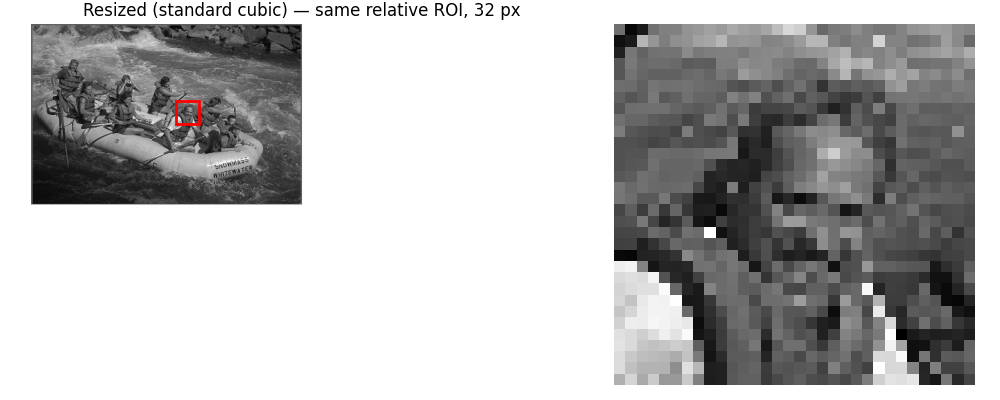
Resized (least-squares, best AA)#
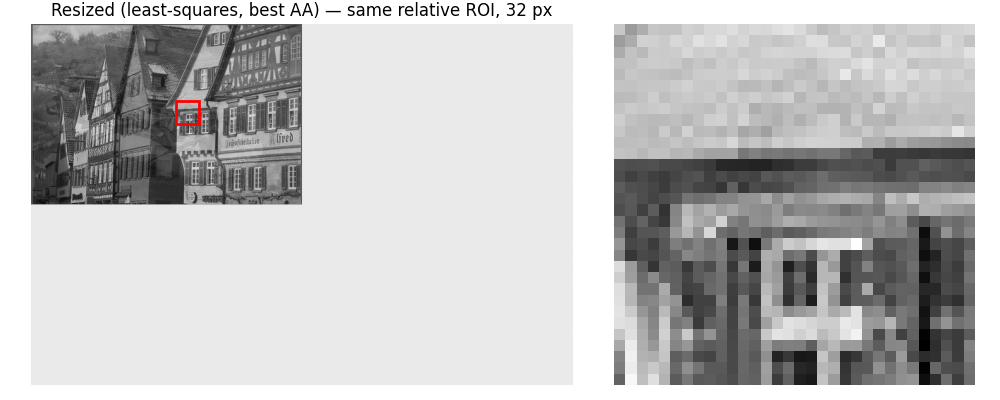
Discussion#
In this synthetic A/B mix, each 2×2 block has A at the top-left pixel and B elsewhere (i.e., 25% A, 75% B per block).
Standard interpolation (cubic) does no prefiltering before decimation. With our odd-size tweak, the 0.5× sampling grid lands exactly on the 2×2 block corners (the A pixels). So it effectively picks A at every step, yielding the A-by-corners image. That’s not anti-aliasing; it’s just point-sampling at a favorable phase for this pattern.
Least-squares projection (best AA) performs a proper low-pass (anti-aliasing) filtering matched to the downsampling, then decimates. On this pattern, that filter averages over each 2×2 neighborhood, so the result tends toward 25% A + 75% B — visually “more B”, more like the mix. This is exactly what anti-aliasing should do: remove the high-frequency checkerboard content so it doesn’t fold (alias) into the downsample.
In short: interpolation without AA does sample-and-aliasing (here it locks onto A due to phase). Least-squares proejction does low-pass-then-sample, preserving what would survive an ideal anti-aliased decimation.
Total running time of the script: (0 minutes 5.573 seconds)
